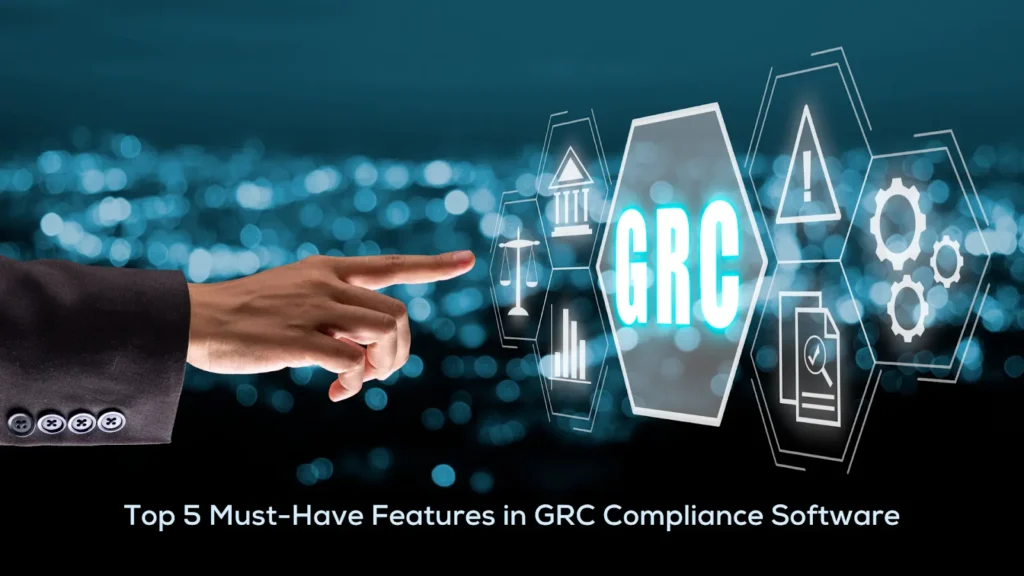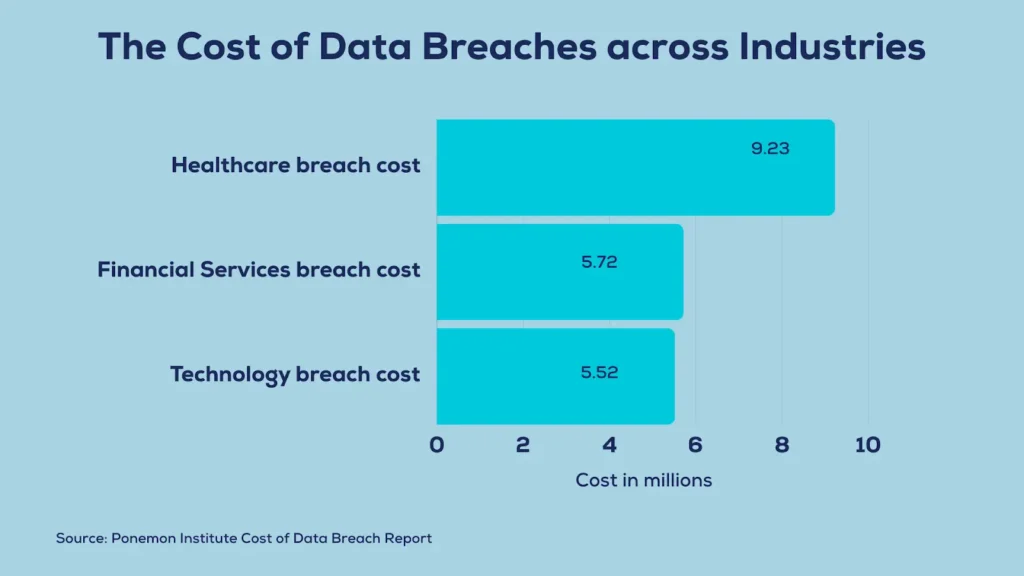Effective governance, risk, and compliance (GRC) management is essential for modern businesses to navigate complex regulatory environments. This article explores the top five features that any GRC compliance software must possess.
These features ensure comprehensive oversight and seamless integration into organizational workflows, from streamlined risk assessment to robust reporting capabilities. Stay ahead of regulatory challenges and optimize compliance efforts with suitable GRC software solutions.

This article outlines the top 5 capabilities to evaluate when selecting a future-proof GRC system for your organization.
The Importance of Prioritizing Capabilities
With the GRC software market estimated to reach $27.1 billion by 2027, there is no shortage of vendors vying for your business. However, narrowing down the GRC compliance software solution most aligned to your governance, risk, and compliance goals involves careful analysis of the functionalities that matter.
This requires moving beyond basic feature checklists to evaluate areas where risk exposure is heightened, and processes are manually intensive. Customizing based on organizational maturity and industry regulations is equally essential. For instance, healthcare entities may prioritize endpoint security integration while public sector agencies focus on audit trail capabilities.
Investing in GRC compliance software that aligns tightly with specialized needs enables enterprises to realize faster value across high-risk domains and free up budgets for optimizing other tools to maximize outcomes.
Seamless Integration
IT leaders emphasize integration capabilities as a fundamental prerequisite in GRC software. The solution should provide out-of-the-box connectivity with existing infrastructure like ERPs, CRMs, content management systems, and communication platforms.
Benefits include:
Streamlined Data Sharing – Open APIs and pre-built connectors create a centralized data-sharing architecture between GRC and other business systems. This breaks down enterprise data silos, enhancing visibility.
Automated Syncing – Bi-directional syncing ensures real-time updates across integrated systems, eliminating tedious manual efforts. Updates on risk incidents in service management tools can auto-sync with GRC platforms for instantaneous reporting.
Enhanced Data Accuracy – By reducing duplicate data entry, automation through system integrations improves data accuracy, ensuring precise risk management and compliance reporting.
Comprehensive Risk Management
The risk management capabilities of GRC software determine its effectiveness in governance. Key features include:
Custom Risk Frameworks – Flexible risk matrices that define risk categories, weights, and tolerance levels tailored to your industry. Additionally, customize the assessment methodology based on impact, likelihood, and other criteria.
Intelligent Risk Assessments – Predictive analytics identifies risk warning signs through emerging patterns and anomalies in data. Combined with automated assessments against pre-defined criteria, this enables dynamic risk quantification for informed mitigation.
Risk Process Automation – Streamline traditionally manual tasks like risk surveys, control testing, and policy attestations through workflows for responsive risk treatment. Further, bolsters risk governance through AI-based remediation recommendations.

Regulatory Compliance Management
Given the frequent evolution of regulations, reliable GRC software streamlines compliance through:
Consolidated Compliance Hub – Maintaining an up-to-date central library of regulatory mandates spanning geographic regions. Further enables compliance policy management and control mapping under one platform.
Smart Compliance Assessments – Leveraging automation and AI, continuously monitor changing compliance requirements and run scheduled self-assessments to determine adherence levels.
Proactive Change Management – Implement robust ‘what-if’ analysis of new regulations, including conflict checks across existing rules. This accelerates compliance readiness amidst constantly shifting mandates.
Interactive GRC Dashboards
Ensuring quick access to GRC insights is pivotal for data-backed decision-making. Core capabilities include:
Tailored Visualizations – Personalize dashboard views aligning to each user’s focus area, risk treatment, compliance audits, or policy exceptions. Visualize metrics using charts, graphs, and risk heat maps for at-a-glance monitoring.
Drill-Down Analysis – Facilitating investigation of specific high-risk incidents, compliance gaps, and governance issues through easy drill-downs to the source. This aids in timely root cause analysis.
Audit Trail – Every GRC process update results in automated audit logs for detailed reporting. This caters to internal audits while demonstrating operational accountability.
Cloud-based Scalable Infrastructure
The responsiveness of GRC systems to evolving business needs relies heavily on their underlying infrastructure. Key requirements include:
Rapid Scalability – Leveraging the unlimited storage and computing potential of the cloud, instantly scale your GRC landscape to onboard new products, operational sites, and geographical markets.
Always-On Accessibility – Far surpassing legacy on-premise systems, leading cloud GRC vendors guarantee over 99% system availability alongside disaster recovery protections for 24/7 functional continuity.
Enhanced Data Security – Modern data centers provide advanced security, including encryption, access controls, and high availability, reducing reliance on internal IT resources for infrastructure management.
Supporting rapid change absorption alongside digital innovation opportunities like process mining and automation, cloud-based GRC software ensures future-proof investment protection.
Key Considerations at a Glance
| GRC Software Features | What to Look For |
| Integrations | Open APIs for custom integrations, pre-built connectors, bi-directional sync |
| Risk Management | Custom frameworks, predictive assessments, and automated workflows |
| Compliance Management | Consolidated regulatory content, AI-powered monitoring |
| Dashboards and Reporting | Interactive visualizations, personalized views, and detailed drill-downs |
| Infrastructure | cloud-based platform ensuring scalability, accessibility, and security |
As organizations navigate complex digital environments, scaling risk, compliance, and governance capabilities is imperative. While point solutions have traditionally hampered performance through disjointed workflows, consolidated GRC software comes as a game-changer, enabling responsive and data-driven decision-making.
By investing based on solution capabilities vs. stop-gap checks, enterprises can accelerate toward risk resilience and compliance excellence.
Frequently Asked Questions
How does GRC software ensure data privacy and security?
Leading GRC vendors implement robust data protection through encryption, access controls, and stringent cybersecurity to comply with regulations like GDPR and CCPA. Cloud-based solutions additionally enforce checks like periodic penetration testing and redundancy mechanisms across data centers.
What is the typical ROI from GRC software?
The typical ROI from GRC software varies widely depending on factors such as company size, industry, and specific use cases. However, studies suggest that organizations can achieve ROI ranging from 100% to over 300% within the first year of implementing GRC software, primarily through cost savings, efficiency gains, and reduced risk exposure.
How long does the GRC software implementation take?
GRC rollout spans across three phases – design, implementation, and change adoption – lasting between 6-9 months for full-scale transformation. Taking a phased approach by prioritizing high-risk domains allows for maximizing value faster through agile delivery models.
Can GRC software integrate with custom applications?
Modern GRC solutions provide open APIs and cloud service integrations to connect with both standard and customized applications across your environment. This facilitates organization-wide data aggregation for a single source of truth.
Conclusion
As regulatory complexity and business risks continue to intensify, organizations require an adaptable software foundation to drive governance, risk, and compliance outcomes. This article outlined 5 key capabilities: seamless integrations, customizable risk management, automated compliance, interactive reporting, and cloud-based agility – that enable responsive GRC across changing business landscapes.
However, needs vary based on factors such as industry, size, and geographic footprint. Thorough stakeholder interviews and mapping of current workflows are recommended before finalizing a technology partner. The right solution balances robust functionality with ease of use and automation enablement based on your maturity.


